
The additional TBM is subject to approval by the NSW Department of Planning, Housing and Infrastructure.
New ground testing techniques have provided a better understanding of the extent of a complex fault zone on the route of the 17km tunnel that will connect Snowy 2.0’s upper reservoir to its underground power station.
Snowy Hydro CEO Dennis Barnes said activating a fourth TBM was the right action, given that what was now known about the tunnelling challenges ahead had provided the opportunity to mature the design.
“We’ve always known the fault zone was there and I’ve said in the past we will need to take action,” said Barnes.
”While the fault zone is not a surprise, further ground testing since the project reset has revealed it is far more geologically challenging than earlier investigations indicated.
“We’ve carefully considered a range of options to get through the fault zone and overcome the initial design immaturity. Bringing in a fourth machine is the best way to keep Snowy 2.0 on track for its target completion date of December 2028.”
Subject to planning approval, the new TBM will be launched before the end of 2025.
A modification for Snowy 2.0’s project approval has been submitted to the NSW Department of Planning, Housing and Infrastructure, and will be subject to the department’s independent community consultation and assessment processes.
The planning modification seeks approval for a change to construction methods within the project’s already approved work zone. There is no proposal to increase approved land clearing areas, surface or groundwater impacts. Local communities will be consulted about relevant changes to construction methodologies.
“We’re mindful that we are building Snowy 2.0 in a precious and protected national park. We have worked diligently to arrive at a proposal that does not step outside our existing construction area or increase our already approved impacts,” said Barnes.
He said he remained committed to transparency regarding the project, given the inevitable challenges ahead.
“Just like the construction of the original Snowy Scheme, this is one of the most challenging and complex megaprojects under way in the world,” he said.
“The fourth TBM is an example of adapting to the situation in front of us, so we are doing everything we can to safely meet Snowy 2.0’s delivery timeline.”
While the need for a new TBM was driven by new information about the fault zone, Barnes acknowledged that the disappointing performance of Florence, the TBM excavating the same tunnel the new machine will also work on, had contributed to the need to take significant action.
“It’s difficult to say with certainty whether the same action would be needed if Florence had performed as we had hoped. However, it’s likely that the fourth machine would still be needed,” said Barnes.
TBM Florence was stopped in May this year when hard and abrasive rock impinged on the shield. She restarted in July.
This followed a year-long halt to boring the headrace tunnel when, in December 2022, TBM Florence was stopped when a surface depression developed as she transitioned from soft material into harder rock conditions.
Snowy 2.0, being built by Future Generation JV, comprising Webuild, Clough and Lane Construction, is Australia’s largest renewable energy project. It will link Tantangara Reservoir (top storage) with Talbingo Reservoir (bottom storage) through 27km of tunnels and a power station with pumping capabilities. This will enable water to be released for energy generation at times of peak demand and pumped back to the top storage when there is excess renewable energy in the system, ready to generate again.
“Snowy 2.0 is critical to Australia’s energy future. We need to get this job done,” said Barnes.







